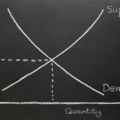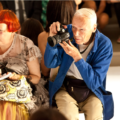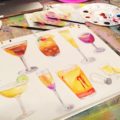06 Jul Bits & Pieces with Susan Weinthaler
Susan Weinthaler is an artist who thinks “outside the box” and creates “Bits.” These are small magnetic materials mounted on a steel canvas that can be independent works of art but are meant to be arranged together to create a larger and more meaningful piece of art. Magnets allow for ever-changing art. Weinthaler lives and creates in her studio in New York City and has worked with individuals, interior designers, architects, and corporations to create custom commissions. Her work lies in private collections all around the world!
Describe your personal style of work.
Life is not rigid, so if art is about life then art should also be flexible.
With this in mind, I make Bits, which are small objects of art outfitted with a magnet on the back and grouped together on a steel surface so as to create something larger, something with a life force. The idea is that it’s a system for manipulating artistic information in a very concrete and physical way. The client can change its configuration over time, either hourly, daily or seasonally depending on their mood. My work is quite similar to jazz, in that it’s always an improvisation of composition.
I try to live by Claes Oldenburg’s quote, “I’m in favor of an art that does something other than just sit on its ass in a museum”.
What was the inspiration/story behind your art?
I guess it all began around 2003 as I was wandering the streets of New York pondering just how many bricks there were in the entire city, in all five boroughs, everything above and below ground, including all the buildings that have been demolished and rebuilt over time. The complex urban organism is staggering, and the more I looked at the world around me with this in mind, the more I saw this theory happening in everything, everywhere.
At that time I had a studio in Williamsburg, Brooklyn, and there was a dumpster right outside of my door that belonged to a wood shop upstairs. It was filled with the most amazing scrap lumber, so I took it. I didn’t yet know what I was going to do with it, but it was free and money was tight. Needless to say, it got a little out of control, and at some point I had to figure out a better way to manage the materials.
My solution was to cut it all up into equal sized “bits” for more efficient storage, and since most scrap was under 3”, the standard unit of measurement ended up being 2”x2” (circles or squares only). It was a random choice of size, but a single Bit fit in my hand nicely. I figured I would make art one “bit” at a time, create a system, like a visual database, and see what would happen.
A dear friend introduced me to a new book that had just been published, “A New Kind of Science”, by Stephan Wolfram, and the diagrams just blew my mind. In it he explained that complexity is essentially built on simplicity. Then it all made sense, and Bits is was.
How did you get your start?
Drawing came easily from the beginning, and from a very early age people hired me to do portraits of various things – people, houses, animals, etc. I think I was 8 when I sold my first drawing, and have been working as an artist in different capacities ever since.
But if you’re referring to the launch of my Bits, that got off the ground in 2007 when I met Ombretta Agro while strolling through Storm King Art Center one gorgeous Spring day. She worked with Rena Glickman as partner curators in NYC at the time, and they agreed to represent my work in art fairs and pop-up shows. They were the first to believe in my vision and excited to introduce this new work to the world, and for that I’m eternally grateful. My career has certainly expanded since then, and I now work with numerous agents and reps, architects and designers. I’ve been incredibly fortunate to develop outside of the gallery system and sell directly to collectors.
Where do you find design inspiration?
We live in a modular and flexible world. I am inspired by atoms, cellular structure, DNA, petri dishes, amoebas, viruses, electricity, explosions, clouds, fire, water, grains of sand, flocks of birds, migration patterns, pixels, databases, spread sheets, Conway’s Game of Life, Chinese Game of Go, poker chips, money, mosaics, the periodic table of elements, fractals, set theory, Venn diagrams, infinity, alphabets, numbers, words, language, bricks, tiles, etc. The list goes on and on and on.
What materials and colors do you prefer to use the most?
Bits are almost always made from scrap lumber gathered around New York City, but Bits are merely an opportunity to experiment with content, materials and technique, so I prefer variation on the surface. I’ve used diverse materials such as paint, photography, fire, wine, leather, glitter, mirrors, maps, novels, comic books, concrete and resin to name a few.
Blue is definitely my favorite color palette, I always come back to it. Presently, I’m making blue “flame” Bits, because, you know, blue flames are the hottest.
What does your creative process look like?
Like a black hole, inhaling everything at the speed of light, then churning, stretching and pulverizing it before it is somehow recreated it on the other side.
There are certainly times of input and time of output. It’s finding the balance between the two that can be difficult. I will spend extended stretches of time just absorbing things around me, reading, traveling, researching and observing the world. The beauty of my process is during these times of contemplation I can do prep work on my bits and let my mind wander.
Do you have a favorite of your own art pieces/arrangements?
Probably PANIC. Not only was it a major departure of technique at the time, as I used a blowtorch to treat these particular bits, but it ended up being sold to a collector in Telluride, Colorado, that already had an existing a steel fireplace in his home. To me, the simple poetry of its placement over a roaring fire totally elevated and extended the overall piece.
How do you decide what bits to present to a client?
Conversation, research and instinct play important roles in deciding what direction to go with each project. I’m always looking to try something new, so I welcome the collaborative process that is part of a commission. There are many other factors that also play key roles, such as the architecture and design of the space. I want my work to belong in its environment.
You encourage those who obtain your art to interact with each piece. How does this impact the concept behind the piece?
It is the whole point. I’m interested in exploring the infinite possible configurations, and by encouraging my clients to keep the piece in motion they are helping to fulfill the original intention behind the work.
What inspired your custom piece you made for Starbucks?
I have to thank Erin Przekop of Fiercely Curious for introducing my work to the people at Starbucks. She is my first inspiration. But Starbucks, as I understand, is named after Mr. Starbuck, Captain Ahab’s first mate in Herman Melville’s novel, “Moby Dick”. The three partners who started the business met at the University of California in the 1970’s, and were told by a dear friend with some advertising experience that names with the prefix “st” do well. They immediately thought of Starbuck, because all of them were lovers of literature, and there is one sentence in the entire book where Mr. Starbuck is thinking about coffee with fondness and desire, much like Sirens to Sailors.
I was asked to dissect the novel and incorporate it into a collection of Bits for their flagship store in Williamsburg, Brooklyn, because Brooklyn also has its own significant history with whaling and sailing. And coffee. And art.
Their art directors had seen my first “literary” Bit collection, WALTZ, where I combined Thoreau’s “Walden Pond” and Mandelbrot’s “Fractals in Nature” with my own flock of “bird” bits as a conversation about nature, and they wanted me to do something similar with Moby Dick for this particular location. I had not read the book previously, so I bought a beautiful hardbound copy and many cups of coffee (which I intentionally spilled all throughout the book), and proceeded to work my way through the epic tale. It was all consuming. What a fantastic read straight through. I have never read a book of such enormity so quickly.
I then came across a beautiful broken lathed wooden table leg in a pile of garbage as I was walking my dog one day, and it dawned on me that this particular collection should be made from broken furniture legs, as a direct reference to Captain Ahab’s own compromised wooden leg. So I did. There is a place in Brooklyn that recycles all kinds of donated materials, and of course, they had a big barrel of broken table legs. I bought all the ones painted white, like the whale, and cut those up too.
How did your process and end product differ for this commercial space and well-known brand?
The process and end product did not really differ from other commissions, but rather the difference is that this project is incredibly public. It is in near perpetual motion. I absolutely love that.
If you weren’t an artist what would you be?
A constellation.
What’s next?
Steel walls. I’ve got a few irons in that fire already. Juan Alfaro Design is installing floor to ceiling steel on the wall of his conference room that will showcase their talents and feature my Bits.
Industry City, where my studio is, has built out one of their dreamy courtyards with angled steel walls and we are presently planning for outdoor pop-up shows this fall. I also have a meeting lined up with a real estate developer here in NYC to discuss the possibilities of working on a larger scale.
Steel “furniture” too. All I really need is a steel architectural environment for Bits, so I welcome other people’s ideas as how else to display my work. For example, architect Alex Scott Porter designed a wine cabinet that also functions as a steel canvas to display my Bits on the other side.
And I’m thinking of staging mini shows all over New York City on random steel surfaces this fall, using the city as my gallery. Stay tuned.

















No Comments